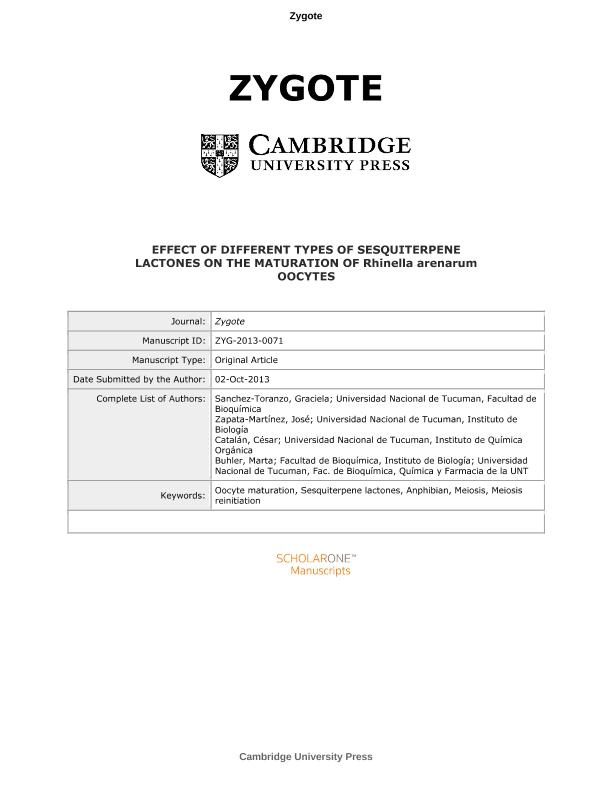Artículo
Effect of different types of sesquiterpene lactones on the maturation of Rhinella Arenarum oocytes
Fecha de publicación:
06/2015
Editorial:
Cambridge University Press
Revista:
Zygote
ISSN:
0967-1994
e-ISSN:
1469-8730
Idioma:
Inglés
Tipo de recurso:
Artículo publicado
Clasificación temática:
Resumen
The sesquiterpene lactones (STLs) are a large class of plant secondary metabolites that are generally found in the Asteraceae family and that have high diversity with respect to chemical structure as well as biological activity. STLs have been classified into different groups, such as guaianolides, germacranolides, and melampolides etc., based on their carboxylic skeleton. In amphibians, fully grown ovarian oocytes are arrested at the beginning of meiosis I. Under the stimulus of progesterone, this meiotic arrest is released and meiosis progresses to metaphase II, a process known as oocyte maturation. The purpose of this work was to determine whether sesquiterpene lactones from the germacranolide and melampolide groups act as inhibitor agents on the meiosis of amphibian oocytes in vitro. Results for germacranolides indicated that the addition of deoxyelephantopins caused a high degree of inhibition and that minimolide showed a moderate inhibitory effect, whereas glaucolide A was inactive. Furthermore, the addition of melampolides (uvedalin, enhydrin, polymatin A and polymatin B) showed inhibitory effects. For enhydrin and uvedalin, inhibitory effects were observed at the higher concentrations assayed. The results of this study suggest that the inhibitory activity of the tested sesquiterpene lactones on the meiosis of Rhinella arenarum oocytes is not dependent on the group to which they belong, i.e. not on the carboxylic skeleton, but probably due to the arrangement and type of function groups present in the molecules. All assayed lactones in the germacranolide group showed low toxicity. In contrast, important differences in toxicity were observed for lactones from the melampolide group: enhydrin and uvedalin showed low toxicity, but polymatin A and B were highly toxic.
Palabras clave:
Amphibian
,
Meiosis
,
Oocyte Maturation
,
Sesquiterpene Lactone
Archivos asociados
Licencia
Identificadores
Colecciones
Articulos(CCT - NOA SUR)
Articulos de CTRO.CIENTIFICO TECNOL.CONICET - NOA SUR
Articulos de CTRO.CIENTIFICO TECNOL.CONICET - NOA SUR
Citación
Sánchez Toranzo, G.; Zapata Martínez, J.; Catalan, Cesar Atilio Nazareno; Bühler, M. I.; Effect of different types of sesquiterpene lactones on the maturation of Rhinella Arenarum oocytes; Cambridge University Press; Zygote; 23; 3; 6-2015; 406-411
Compartir
Altmétricas




